
Historic Mt. Pleasant farm was donated for preservation by Ruth and Frances Brown, retired Howard County schoolteachers. It is now used for our educational programs, special events and is open to the public for hiking, exploring our nature center, and visiting the John L. Clark Honors Garden. Gardens, farm fields, streams, and mature hardwood trees frame the historic farmhouse. Multiple outbuildings surround the house: the carriage house, blacksmith shop, bank barn, wagon shed, corn crib, smokehouse, chicken coop, guinea fowl coop, ice house foundation, and outhouse. The house and outbuildings were built by generations of the Brown family and were present when the Conservancy took ownership of the farm in 1993.
In 2003, through the efforts of a number of partners and donors, the Conservancy was able to save the historic Montjoy Barn. Dating from the 1700s, this barn was located on an 85-acre property in Ellicott City that was slated for development. It is now the first building you will see when coming down the driveway to Mt. Pleasant. The barn was disassembled, restored and reconstructed in 2007.
A new equipment barn was constructed in 2021, housing the tractor and other equipment used for maintenance of the trails, gardens, and restoration areas. It is located opposite the bank barn.
The History of Mt. Pleasant Farm
Various historical records show both Susquehannock and Piscataway tribes having a presence in
Woodstock, the home of the Howard County Conservancy. There is also evidence of an Algonquin Indian
site either in or near Woodstock and an important Indian trail that crossed the Patapsco at the site of
Woodstock. Both tribes were proficient farmers, hunters and gatherers and lived in wigwams in seasonal villages. You can learn more about the Native American history here.
To learn more about Native Americans in the region visit:
History: https://www.chesapeakebay.net/
Maps: https://native-land.ca/
In 1692, Thomas Browne was commissioned by the colonial government as a Patuxent Ranger to survey the area between the Patapsco and Patuxent Rivers and to observe the activities of the Native Americans. He received Ranter’s Ridge as a land grant in 1703. This land, which became known as Mt. Pleasant, remained in the Brown family for eight generations until Ruth and Frances Browns’ deaths in the early 1990s. The Howard County Conservancy, founded in 1990, took ownership of Mt. Pleasant in partnership with the Maryland Department of Natural Resources and the Howard County government in 1993. The entire 232-acre farm is under conservation easement, held in perpetuity by the Maryland Environmental Trust. This property will never be developed.
While records are limited, there is evidence enslaved people lived at Mt. Pleasant in the 1800s. The 1850 Federal Slave Census shows Samuel Brown’s wife, Elizabeth, owned 14 slaves – three men, two women and nine children.
Chronology
1651 Thomas Browne, father of Ranger Brown, migrates from Nansemond, Virginia (now Suffolk) to Maryland and settled in Anne Arundel County.
1692 Thomas Browne, known as the Patuxent Ranger, is commissioned by the governing body of Anne Arundel County to survey the lands at the headwaters of the Patuxent River and its tributaries. As a Ranger, he is charged with keeping watch over the activities of the Native Americans in the area from what is now Laurel to the northern borders of Anne Arundel County along the Patapsco River. This area includes some of the headwater streams of the Patuxent River and is now part of Howard County.
1703 Ranger Browne is given a land grant for 415-acre parcel named Ranter’s Ridge.
1715 The Patuxent Ranger dies, leaving four sons. The lower part of Ranter’s Ridge is left to the youngest son, Joshua.
1728 Joshua acquires 100 acres of Good Fellowship, an adjacent parcel. In the course of numerous land exchanges and transfers, the “e” was dropped from the Browne name, making Joshua one of the first Browns in Upper Anne Arundel (Upper Anne Arundel became Howard County in 1851).
1774 Upon Joshua’s death, the land passes to his grandson, Capt. Samuel Brown.
Circa 1775 A one-room log cabin is built. There is much debate on an exact date. We believe the Ranger Thomas Browne undoubtedly constructed some type of temporary shelter or “settler’s hut” on the property. However, recollections by Ruth Brown indicate that the one-room log cabin, which is now part of the farmhouse, was not built until the mid-1770’s.
1833 Capt. Samuel Brown leaves the property to his grandson, also named Samuel.
1838 Samuel Brown (1810-1880) begins acquiring the 232-acre farm as it exists today. He purchases 192 acres of the Hammonds Ridge tract from Thomas Herbert and in 1859 an additional 40 acres from his brother John from the Good Fellowship tract. During this time a second story to the log cabin and an addition on the north side was constructed.
1846 Samuel is elected to his first of three consecutive terms as commissioner of the Howard District of Anne Arundel County.
1865 Samuel and his two sons constructed the front addition of the farmhouse consisting of a parlor, foyer, and two bedrooms.
1868 Slavery was abolished in Maryland in 1864, but records continued through 1868. According to the Maryland State Archives, the General Assembly authorized additional documentation in case the federal government would someday compensate former slave owners.
A 1868 ledger shows Samuel Brown owned the following nine slaves before slavery was abolished in 1864.
- Kinsey Johnson, 18, male
- Isaac Sheridan, 17, male
- Kitty Johnson, 16, female
- Mary Chase, 35, female
- Joseph Chase, 14, male
- John Chase, 8, male
- Joshua Chase, 6 male
- Eliza Chase, 2, female
- Emily Conway, 4, female
1878 The jail in Ellicott City is constructed with Samuel’s name, along with the other two commissioners, inscribed in stone under the front gable.
1880 Samuel Brown dies, leaving the farm in trust for his wife Elizabeth, and subsequently to six of his children, including the youngest son, Frank deSales Brown. From then until 1903, Frank acquires the shares of his brothers and sisters and eventually became the sole owner of the farm.
1901 At age 47, Frank marries Sarah Louise Davis.
1902 Several outbuildings, constructed by Samuel Brown, are destroyed by a fire of unknown origin. Frank Brown constructs the existing outbuildings.
1911 Frank deSales Brown dies, leaving the farm to his three children: Samuel Brown (1902-1974), Ruth Davis Brown (1903-1990), and Frances Louise Brown (1906-1992). His wife, Sarah Louise is to retain a life interest. Samuel Brown becomes a Civil Engineer with the Baltimore Water Department. Ruth and Frances become teachers and retire after spending 49 and 48 years, respectively, teaching Howard County children.
Early 1900s A small utility/laundry room with a second-story storage area was added to the west side of the 1865 addition.
Circa 1950 The early 1800s addition to the rear of the log cabin is removed, and the existing rear wing is constructed. Indoor plumbing was added to the farmhouse.
1962 Sarah Louise Brown dies.
1974 Samuel Brown dies, leaving his one-third interest in the farm to his sisters.
Ruth Davis Brown dies in 1990, and Frances Louise Brown dies in 1992, leaving Mt. Pleasant in preservation for the enjoyment of all.
Learn more:
To learn more about the history of the Brown Family and Mt Pleasant, click here to view a book created by our History Committee compiling years of research. Mt. Pleasant Farmhouse Book
Imagine life on Mt. Pleasant back in the 1750s as a blacksmith, with this script written by one of our volunteers. This script is used currently in our middle school field trips to students to rural farm life long ago.

